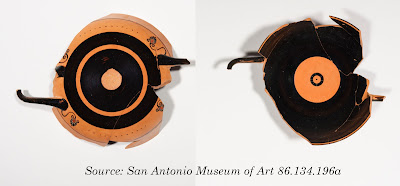These fragments of an Athenian Little Master cup, decorated with 'nonsense' inscriptions are among the pieces being returned to Italy by the San Antonio Museum of Art.
It is a reminder of the way that museums restrict information. The published catalogue, by H. Alan Shapiro, Carlos A. Picón and Gerry D. Scott III merely note that it was a gift of Gilbert M. Denman, Jr in 1986. The Beazley Archive records nothing about its history (BAPD 20266). Yet now it seems that the fragments, including this Little Master cup, had been found at Barbarano Romano, and had been purchased by Edoardo Almagià in 1985. How was such information deemed to have been unknown to those preparing the catalogue?
Were these fragments processed by Almagià with the help of an academic?
Are there other pieces remaining in San Antonio that also derive from Barbarano Romano or other sites in Italy?
Why were such large numbers of fragments acquired by San Antonio? Was there an expectation that other fragments from these figure-decorated pots would be acquired in future years? Was the museum following the pattern of other collections?














